Romanesque art of the 12th century
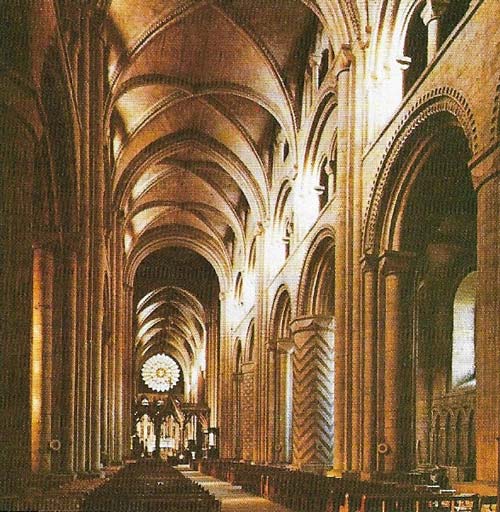
Figure 1. The nave of Durham Cathedral (finished in 1133) is a tentative application of rib-vaults to a main span, but clearly demonstrates the advantages that such a coordinated vault type could bring. The emphasis is still on strength and solidity and the cylindrical piers cannot hide their size behind the simple surface patterns. The chevron or zigzag was a popular motif with Norman builders in 12th-century England.
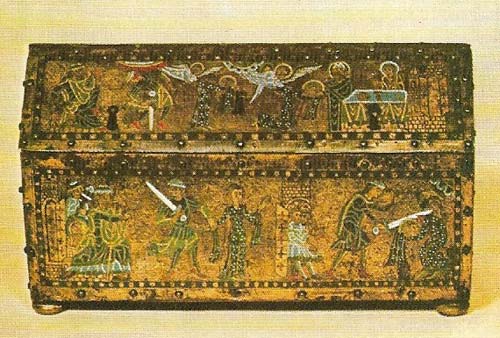
Figure 2. The life of St Valerie, the patron saint of Limoges, is illustrated on this enamelled casket (c. 1170). According to legend,she was engaged to a prince, who found on his return from war that she had dedicated her life to God and so could not marry. The prince then had her beheaded (right). On the lid, St Valerie can be seen, head in hand, walking to mass escorted by angels. This is one of many ornately embellished copper casket reliquaries with attached panels decorated with figures enamelled in blue, red, and turquoise on golden backgrounds. Most surviving medieval enamelwork is on church accessories, the medium lending itself to delicate and glittering small-scale work.
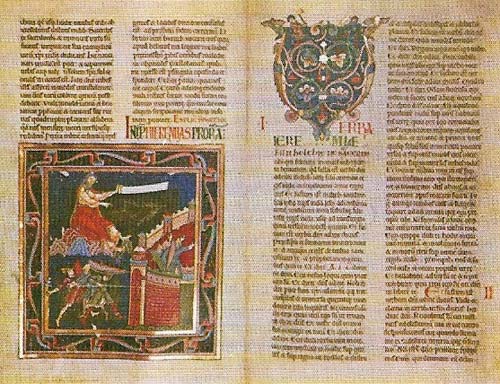
Figure 3. The Bury Bible is an illustrated English manuscript of about 1140. On the left, a large painted panel depicts the scene of the prophet Jeremiah lamenting the imminent fall of Jerusalem. On the right, a decorated initial heads the text with armed men and dragons inhabiting the vine-like foliage. The rich palette, especially the solid background coloring, and the carefully drawn faces are evidence of the high quality of the manuscript.
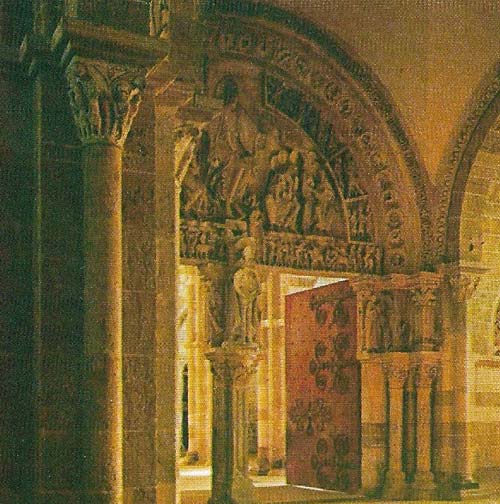
Figure 4. Originally at the west doors at Vézelay fronted the hilltop church. but a large towered narthex or porch was added in about 1150, and this vulnerable sculpture was protected from the weather. It is one of the greatest ensembles of Romanesque carving, full of energetic figures in ample and swirling draperies.
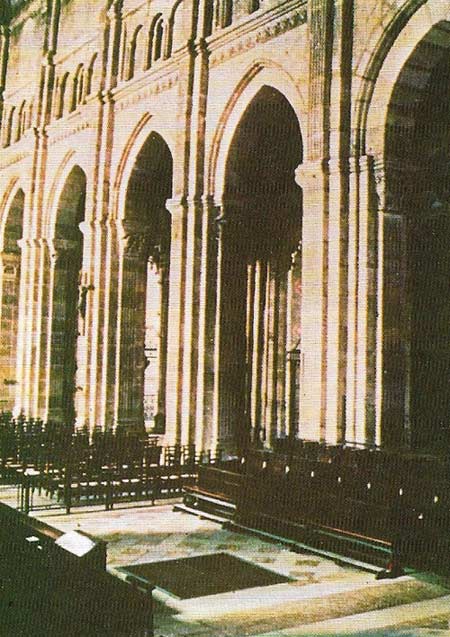
Figure 5. The existence of many Roman monuments in Autun influenced the architectural decoration of the 12th century cathedral there; flat fluted pilasters, for example, were used rather than the usual round shafts. The wealth of sculpture typifies the decorative concepts of a developed Romanesque church.
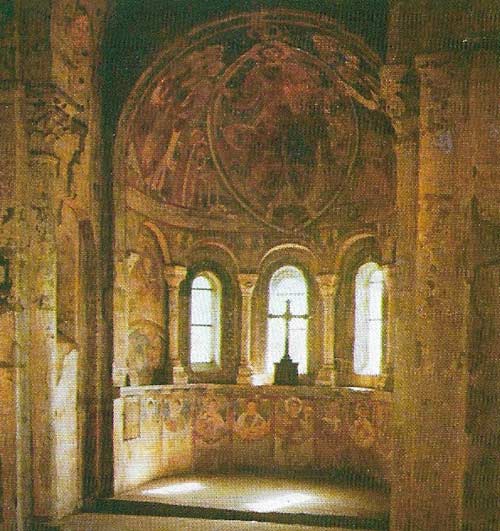
Figure 6. The painted apse of the chapel at Berzé-la-Ville is thought to have been commissioned by Abbott Hugh of Cluny before his death in 1109, and to be a smaller version of the main apse painting of his great abbey church at Cluny. Directly above the altar, Christ sits in glory within an almond-shaped panel surrounded by the Heavenly Host. He is giving a scroll to St Peter, who is holding the keys to heaven. Below the windows there is a range of saints and around the base of the apse wall, simulated drapery. Originally all great churches had such scenes over the altar, often illustrating the martyrdom and life of the saint to whom the altar was dedicated.
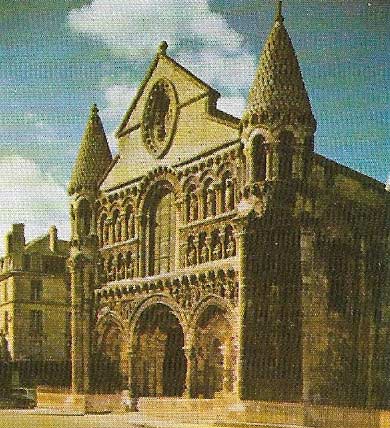
Figure 7. The west façade of Notre-Dame-la-Grande, Poitiers (c. 1140), is considered to be one of the finest in western France, an area noted for its copious use of external sculpture. Also typical of the area are the corner turrets faced by shafts and topped with scale-like stone roofs. Although there is only one central entrance, the custom of inserting three or more deep decorated portals within a grandiose façade was popular in the Middle Ages.
The huge churches built towards the end of the 11th century placed great emphasis on the east end, where the main altars and relics were sited. Outside, the layered walls and roofs of the apsidal chapels, ambulatory, clerestory and perhaps galleries, culminated in mighty towers; inside, the increased use of sculptural decoration and sumptuous church furniture emphasized the respect owed to the shrines in the sanctuary. On entering, usually at the west front, the pilgrim often had to pass under evocative, carved tympana, dominated by a central Christ figure surrounded by the Heavenly Host, or vigorous apocalyptic scenes from the Last Judgment.
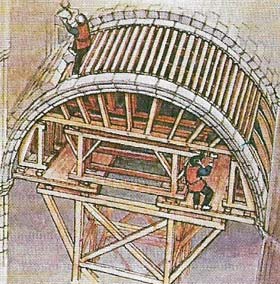 |
| The medieval builder depended as much on resources of wood as on stone because huge scaffolds were needed for the construction of vaults and arches. he arch stones (voussoirs) were placed on wooden centering, the last keystone locking the radiating voussoirs together. Once the mortar had set, the centering was lowered and moved on. Exact workshop practices are, however, difficult to ascertain. |
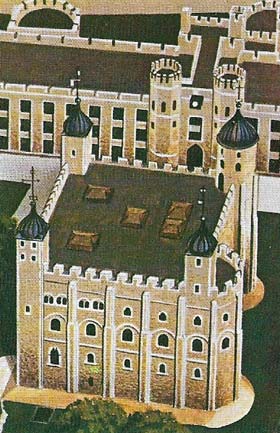 |
| This is the massive central keep of the Tower of London (1078–1097), one of the earliest Norman castles in Britain. Few stone castles existed in western Europe before 1000, but by the end of the 12th century hundreds had been constructed to house nobleman's families and defend their dependants in times of attack. The Crusades gave rise to more sophisticated and expensive techniques. |
Interior decoration by secular artists
The increased use of ashlar had led to greater skill in stone-cutting. Because the walls were now divided into arcades and piers, the didactic and decorative functions of the large-scale wall-paintings were transferred to sculptured capitals and portals (which were then painted) or, in some regions, to stained glass. These capital designs had to follow the lines of the particular structure but a tympanum over a door, or a panel inserted into the wall, had no structural function, so only the shape was determined by architectural factors. Animal and human figures, therefore, had to be reinterpreted and traditional iconography amended to fit these new shapes. For subject matter, the sculptor looked to the older arts of metalwork and manuscripts which supplied an endless variety of suitable iconography. But for figurative techniques, surviving Roman sculpture was undoubtedly influential.
This divergence from the original, and the different treatment of stone, help to explain the many styles that emerged, often with little connection to regional variations. It must be remembered that workshops were composed of itinerant masons, sculptors and painters hired by ecclesiastical patrons, and not of resident monks. Some even autographed their work, like Gislebertus at Autun (Figure 5), or Wiligelmus at Modena. Although a man might specialize in designing secular buildings such as castles and town houses, his workmen would probably also have built and embellished abbeys, cathedrals or parish churches. Decorative details are therefore common to all types of structure from centres of worship to dwelling-places.
Reactions to ostentation
An enormous increase in the demand for church furnishings led to a concentration of lay craftsmen in places where patronage or raw materials were most readily available. Products from centres such as Cologne or Liege (metalwork), or Limoges (enamels) (Figure 2), and sometimes master craftsmen, too, were sent throughout Europe. Similar methods probably applied to the production of illuminated manuscripts (Figure 3), particularly the lavish "picture books" for the personal use of abbots and bishops. Everyday service books, however, were most likely copied out within the cloisters of major monasteries. Such ostentation produced inevitable reactions. In particular, the Cistercian order, led by St Bernard of Clairvaux (1090–1153), returned to the monastic ideals of poverty and purity which they felt had been betrayed by painted sculpture and the liberal use of precious metals and jewels.
In order to display these treasures to their best advantage, the vogue throughout Europe for stone-vaulted churches had to be reconciled with another factor, that of natural, direct lighting. Dark, mysterious interiors were rivalled by open, well-lit spans, the light sometimes being filtered through stained glass. In barrel-vaulted churches the half-cylinder of stone that makes up the roof exerts an even, outwards thrust along its entire length, requiring continuous support. Building windows into these walls therefore compromised the stability of the vault.
In Poitou, the barrel-vault rises directly from the top of an arcade of very tall columns. Large windows in the aisle wall flood the central space with light. However, this was only efficient in narrow, single-aisled buildings, and left the upper half of the church dark. A more practical system shed light from both aisles and clerestory: to achieve this, vaulted galleries above the aisles were used to buttress the main elevation, just below the "springing" level of the main span. This assured stability and allowed small clerestory windows to be made. However, the problem could only be solved by dispensing with continuous support, and this meant new concepts of vault design.
The development of new vault types
In western France, about 1100, great domes were built on huge arches over the main span, which concentrated pressure on the four corners. These were then heavily buttressed. This solution was admirable for the traditionally aisleless churches of that area, but elsewhere, especially in the Anglo-Norman region, aisles surmounted by open galleries as high as the main arcade were considered necessary. Over aisles and around ambulatories, "groined" vaults (formed by two simple tunnel vaults intersecting at right angles) had been used. Again, the four corners provided support so that the walls between could be pierced for windows.
In northern France, from about 1140, such a system evolved, later to be called Gothic. But elsewhere, Romanesque wall architecture continued until the thirteenth century, when the other arts had begun to look for more naturalistic inspiration.
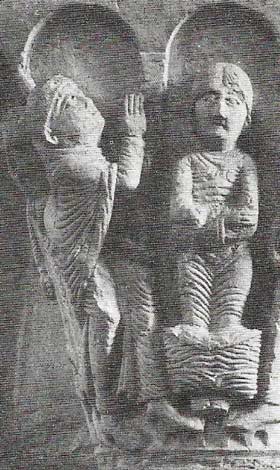 |
| In this detail of capital from the narthex at Vézelay, St Paul (on the left) is praying for the redemption of the world. The function of the capital is to make a smooth transition between the round shaft below and the square or rectangular-shaped masonry above. The Romans used a number of capital types, employing stylized acanthus leaves and scrolls. When figurative scenes were carved out of capitals the sculpture had to conform to the architectural shape and not interrupt the gentle splaying lines. Here, St Paul's leg, back, and head continue the capital's contours, although the actual pose of the figure appears unnatural. |
